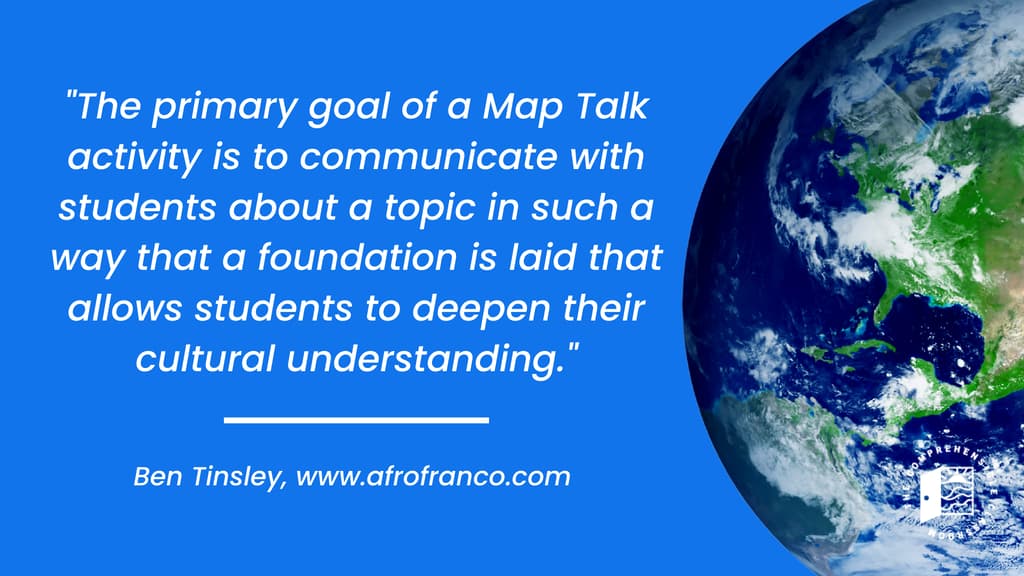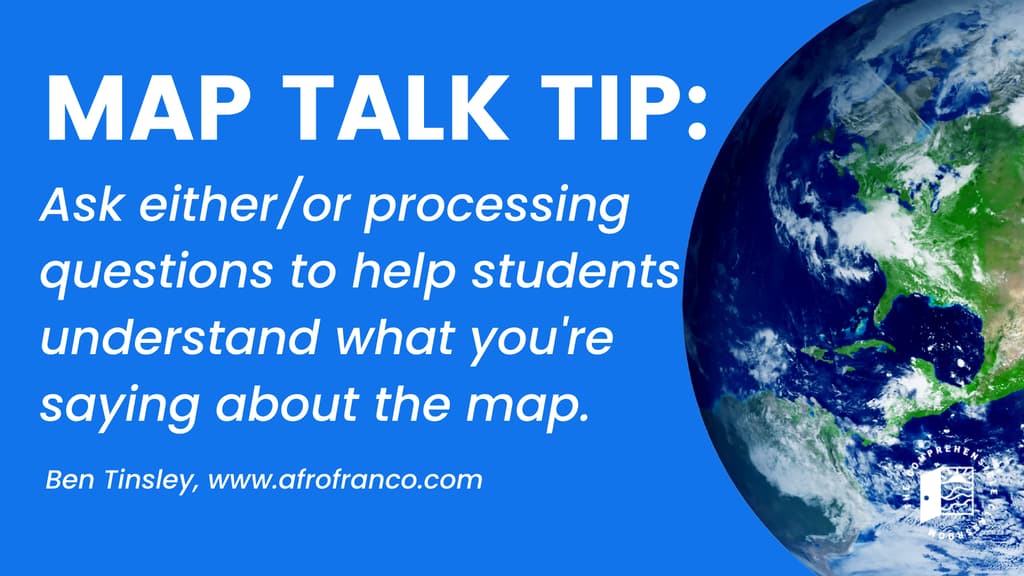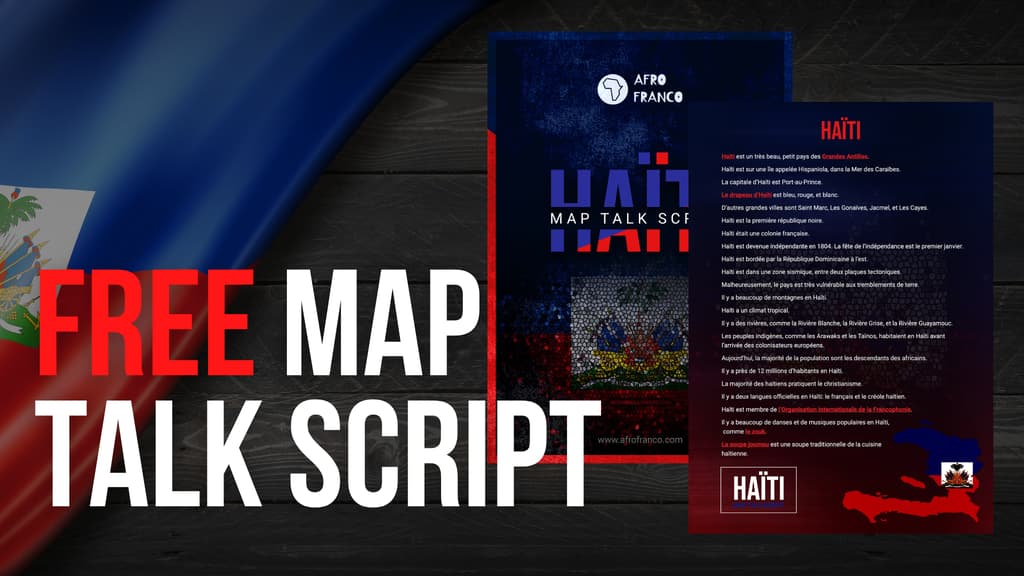Map Talk is a content-based, communicative language teaching strategy that our guest author, Benjamin Tinsley, has been using with his classes and empowering other teachers to try in their own instructional contexts. During a Map Talk activity, the class views a map while the teacher describes what is visible and leads a conversation that combines observation with students’ topical background knowledge and hypothesis.
In this post, Ben explains his “why” behind choosing Map Talk as a core strategy for his classes, how to differentiate conversation during Map Talk activities for Novice through Advanced learners, and how Map Talk meets the standards laid out by advocacy organizations such as ACTFL.
Note to the reader: When Ben began using the term Map Talk and working with the activity that is described in this post, he had not heard it before. It is often the case when many teachers are working toward shared goals and with similar training that mirroring ideas are developed independently of each other. With a little investigation, we learned that Abra Koch used the term Map Talk for a similar activity in her project for National Geographic Educator Certification in 2015. Please take this context into account when sharing the Map Talk strategy with colleagues and considering to whom you will attribute credit.
Map Talk
by Benjamin Tinsley | www.afrofranco.com | Twitter, Instagram: @afrofranco2
Admittedly, I am relatively new to the practice of comprehensible input, or acquisition-driven instruction. It has only been 2 or 3 years since I gave up the verb charts that were passed down to me by previous generations of language teachers. I, like so many of us who go on to become teachers, was one of the rare few who loved learning about grammar. Since discovering and growing within what has been referred to as “CI Teaching” I have been able to foster proficiency growth for so many more students than ever before, and for that I am thankful.
Language proficiency in service of global literacy
Given all of the communicative growth that my students have demonstrated through the many practices I have learned and implemented, I could never shake the feeling that a focus on making language comprehensible in the classroom was often promoting language proficiency at the expense of the practices, products, and perspectives of the PEOPLE behind the languages. For instance, to build language proficiency without intentionally naming who speaks French, why they speak French, and the ways in which their cultures and multi-faceted identities interact with the language is to perpetuate the erasure of those people.
As a young, Black student, my experience in school was to only see myself reflected in the classroom during the month of February, and/or strictly through a very limited lens. As a teacher, I have always made it my mission to address and mitigate that very issue, by centering the stories and voices of Black, Brown and other historically marginalized peoples in my classroom. The challenge quickly became finding a way to combine the urgency of the authentic diversity, equity and inclusion work to which I have been so committed with the linguistic accessibility of comprehensible input.
In comes Map Talks.
What is Map Talk?
Map Talk, in its simplest form, is a Picture Talk where the image being described in the target language is an actual, real-life map. In other words, we use the visual prompt of a map to establish meaning for the language used to describe a place. Accessing students’ familiarity with what they see on the screen, (ie, mountains, rivers, oceans, and cities) creates an entry point for a ton of input in the target language for students at any level.
How does Map Talk lead to language acquisition?
Map Talk is an effective activity to use in courses that are focused on building linguistic competence through implicit language instruction (also known as Acquisition Driven Instruction or Comprehension-based teaching). The primary goal of a Map Talk activity is to communicate with students about a topic in such a way that a foundation is laid that allows students to deepen their cultural understanding. Said differently, the goal is not just to communicate, but to communicate about the world as an entry point to further cultural exploration and connection.
During Map Talk, the teacher must ensure that all students understand all utterances, thereby maximizing linguistic processing– which creates the opportunity for language acquisition. Students are not focused on the individual words or grammatical constructions being used; their attention is on the message being conveyed.
How to start a Map Talk activity
Conducting a Map Talk activity can also require little-to-no preparation on the part of the teacher. If the classroom is equipped with a computer and projector, the teacher can follow the simple steps below:
- Go to the website maps.google.com
- Click on the three horizontal lines in the upper left corner to open the menu.
- Scroll down and click on where it says “Language.”
- Select and click on the target language of your particular class.
- Start asking questions about what you see!
Your first Map Talk activity
I recommend conducting your first Map Talks about your own local area in order to establish meaning for most of the important vocabulary that is necessary to be able to learn about a new place in the world. Students are very likely to be familiar with information such as the town in which the school is located, the nearest major city, nearby bodies of water, et cetera. The first questions should be about those things specifically.
Take a look at some examples below of initial questions and circling that can occur for Novice Level students:
- Is Fort Washington a town or an ocean?
- Of course Fort Washington is not an ocean. It is a small town.
- Is Fort Washington near an ocean? Yes, it is near the Atlantic ocean.
- Is Fort Washington a small town or a state? Fort Washington is a small town.
- Is Fort Washington in the state of New York or the state of Pennsylvania?
- Pennsylvania is a state or a country?
- Is the USA a country or a colony?
These same question formats can be used later on when conducting a Map Talk with Novice Students about other locations. The geographical and cultural context may be new, but the vocabulary will be familiar.
Using Map Talk with Intermediate language learners and beyond
For intermediate and advanced level students, that same line of questioning can become more sophisticated according to what they have in their linguistic toolbelt and their background knowledge. Again, you can focus first on our own locale, and then later move on to other locations. Here are some questions that you might discuss with Intermediate students and beyond:
- What type of climate do we think there is in Fort Washington?
- Who is our town named after? Who was he? What year was he born?
- What is the name of the people who are indigenous to this region?
- In what other modern states did those people live?
- What other ethnic communities do we see in our nearby city? When and why were those communities established?
- What do we notice about the neighborhoods in which those communities are located?
Map Talks help students make content connections
By establishing meaning (both through language and geographical/historical context) with what the students already know locally, teachers then can build upon that background knowledge when exploring a new place within the target culture. In other words, my students now know that the USA is a country, North America is a continent, Washington DC is the capital of the USA located on the east coast, and that Philadelphia is a cultural capital of the state of Pennsylvania, while Harrisburg is the political capital. They have learned or reinforced all of this knowledge in the target language.
Now, when we zoom out and look at Côte d’Ivoire, we can discuss it in a way that is both comprehensible and compelling. Without the teacher necessarily needing to be an expert, we can begin asking similar questions.
- Is Africa a country or a continent? (Sadly, a fact that many adults struggle with.)
- Is Côte d’Ivoire an ocean or a country?
- Is it on the coast or is it inland?
- What cities do we see on the map?
- Is it in the desert?
With a little bit of inquiry (that, importantly, can happen alongside the students), we can start to learn more about things like the population size, what other languages are spoken there, what the common religions are, the different indigenous peoples that live there, et cetera. Additionally, intermediate and advanced level students can do some pretty sophisticated comparative analyses of what they know about different places in the world. Conduct a few Map Talks, then hand the students Venn diagrams and sit back and watch them work! Even in Novice-level classes, students can engage in comparative analysis using Venn Diagrams. To scaffold their language, simply give them the descriptions that could go in different sections of the diagram, and have students place them in the correct area.
Map Talk and the 5 C’s
Now, when I think back to what I felt were some gaps in other strategies commonly used by teachers that have focused their practices on providing students with Comprehensible Input through communicative exchanges in class, many of those have been addressed by implementing this simple practice of Map Talk.
If my word is insufficient, take a look at the ACTFL World-Readiness Standards (aka, the 5 C’s) and let’s see the extent to which a Map Talk, at least serves as an entry point for addressing these standards:
Communication: Communicate effectively in more than one language in order to function in a variety of situations and for multiple purposes.
Cultures: Interact with cultural competence and understanding
Connections: Connect with other disciplines and acquire information and diverse perspectives in order to use the language to function in academic and career-related situations.
Comparisons: Develop insight into the nature of language and culture in order to interact with cultural competence.
Communities: Communicate and interact with cultural competence in order to participate in multilingual communities at home and around the world.
Map Talk is a tool for developing interculturality and global literacy
In my own development of the Map Talk practices, I have seen not only what students are able to do with the language, but also how much they have grown in their global literacy. Here is an example of one of me listening to and reacting to one of my students doing an unscripted retell of a Map Talk on Senegal. This student in particular had otherwise been convinced that they hated French and that they were terrible at it, yet here they are speaking in sentences and series of connected sentences.
Get free Map Talk resources for your classes
I am beyond grateful for the ways in which this practice has transformed my classroom. I am thrilled about the many teachers who have shared with me that Map Talks have been a hit for their students as well. For French teachers in particular, please feel free to grab a free Map Talk script of Haïti (in honor of my childhood neighbors who embraced me and first ignited my love of languages).
All other teachers of language, please take a look at some examples of Map Talks and the many extension activities that come from it that I’ve shared on my blog. Otherwise, find me on Twitter & Instagram at @AfroFranco2 and tell me all about the amazing things you are doing in your classrooms!
I look forward to building with you all! May you have a restful and restorative summer, and come back with a renewed and reignited love of learning to share with your extraordinarily lucky students!
Resources from Afro Franco
Click each image to learn more about the resource!
About the Author:

A French teacher of 13 years and lifelong student, Ben has dedicated his professional and personal life to the pursuit of substantive diversity, equity, and belonging in education. Through AfroFranco, he has worked with teachers around the world to develop curricula that center Black and Brown voices in the classroom and beyond.
Ben’s recent work has focused primarily on leveraging language acquisition and language education toward developing global literacy and 21-Century competencies.
Guest blog posts on The Comprehensible Classroom blog are by invitation only. If you loved this post, please connect directly with Ben at www.afrofranco.com, on Instagram, or on Twitter.












